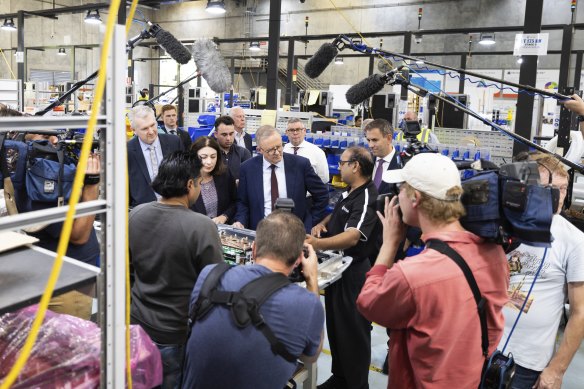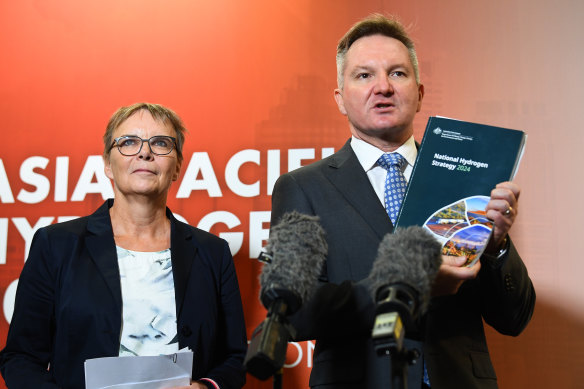By Mike Foley
A hydrogen power plant to initially be fuelled by dirtier diesel, a futuristic steel project at risk of insolvency before it goes green, an electric car charger manufacturer gone bust and Twiggy Forrest ditches his hydrogen production deadline and cuts hundreds of jobs.
This year has seen a steady string of setbacks to the Labor Party’s 2022 election pitch, which spruiked a vision of green hydrogen exports and a flourishing clean manufacturing sector – all of which would be fuelled by the party’s ambitious climate agenda.

Then opposition leader Anthony Albanese visits the Brisbane factory of Tritium in April 2022, during the election campaign. Credit: Alex Ellinghuasen.
“Our ambition is nothing less than a revival of manufacturing built off the back of the availability of clean, cheap energy,” Prime Minister Anthony Albanese said in April 2022, before the election.
Experts say Australia’s green manufacturing dreams are far from dead, but campaigning on that same message in the next election, due by May 2025, will be far more problematic.
Why? Because the new green industries are yet to enter commercial operations, a raft of high-profile green projects have faltered.
The government has pinned much of its hopes on scaling up a green hydrogen industry – produced via an emissions-free process that uses renewable energy to release hydrogen from water – to displace fossil fuels in some heavy industries that can’t be powered by electricity.
Mining magnate Andrew Forrest has set the world’s most ambitious targets for production of the clean fuel, aiming to produce 15 million tonnes of green hydrogen by the end of the decade. But in July his company Fortescue announced hundreds of jobs losses and abandoned its target, as the company focused its energy on bringing down the cost of production.

German State Secretary Anja Hajduk and Climate Change and Energy Minister Chris Bowen announced a deal to jointly fund $660 million of hydrogen development earlier this month. Credit: AAP Image
Energy minister Chris Bowen’s 2022 $1 billion commitment to convert the Morrison government’s Kurri Kurri gas plant into a green-hydrogen generator, known as the Hunter Power Project, has no timeline for supplies of the clean fuel in sight. Owned by Commonwealth corporation Snowy Hydro, the plant will now burn diesel fuel when it commences operations in December, with plans to switch to gas when a pipeline is connected in February next year.
A spokesperson for Bowen said tax incentives are a pay-on-deliver mechanism that encouraged investors to develop manufacturing facilities in Australia, given the guarantee of financial support once production was reached. The government would work with industry to refine its support, but it said its tax credit program was intended to expand, rather than streamline, the range of technologies open to investors.
“The strategy identifies green iron, alumina and ammonia as promising focus areas, however the strategy is not designed to close off other possible commercial use cases or emerging markets for hydrogen,” the spokesperson said.
Electric vehicle charger maker Tritium was visited by Albanese during the election campaign, and once again in March 2023. He touted it as a shining example of green manufacturing, but the plant was relocated to the US to revive its fortunes and finally, collapsed in April.
The South Australian government has sought advice on the future of Liberty Steel’s Whyalla’s plant, which went offline last week. The company, which has received more than $100 million in state and federal grants, has plans to replace its coal-fired blast furnace with an electric arc furnace to become carbon neutral by 2030. South Australian Premier Peter Malinauskus told The Australian his government was developing proposals to overcome the “challenges that are currently being experienced at the steelworks”.
The federal government’s May budget included nearly $23 billion for the Future Made in Australia fund including $9 billion for green hydrogen and $1 billion for solar panel manufacturing, and $523 million for battery making.
Bloomberg New Energy Finance Australian head Leonard Quong said the same challenges that confront the next wave of green technologies in hydrogen and green manufacturing also confronted renewable energy.
Wind and solar power were once viewed as risky and expensive, but they are now the cheapest form of electricity generation and supply 40 per cent of Australia’s electricity grid.
“We saw this with renewable energy in the very early days when there was a lot of noise about what they could do, but costs went up very quickly and some of that initial hype evaporated. But now we see that they are absolutely transformative.”
Grattan Institute energy and climate change deputy program director, Alison Reeve, said green hydrogen manufacturing can overcome the hype cycle in the same way as renewables.
“There’s a lot of dumb uses for hydrogen,” said Reeve, who formerly worked as a public servant that helped write the federal government’s first national hydrogen strategy, released in 2019 by then Chief Scientist Alan Finkel.
“What worries me about the tax credit is that we will chew up a fair bit of that tax credit on using things for hydrogen that we already know are probably going to be dead ends, and we won’t have put the effort into getting the hydrogen production happening in the right places.”
Reeve and Quong said Australia has great natural advantages to build globally-competitive industries, with abundant supply of wind and sunshine as well as resources like iron ore and alumina.
They said government should target initiatives that could lower the cost of hydrogen production and kick-starting local industries to make iron, alumina refining and production of ammonia, which is used in fertiliser and explosive manufacturing and currently produced with gas.
Get to the heart of what’s happening with climate change and the environment. Sign up for our fortnightly Environment newsletter.